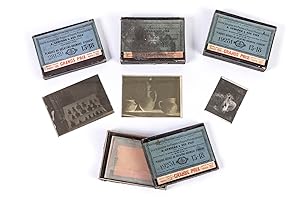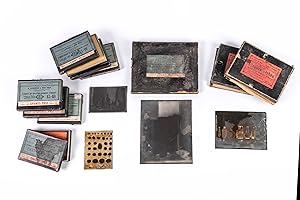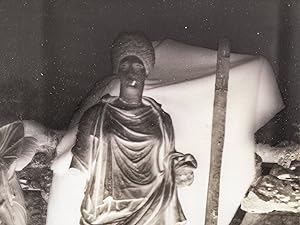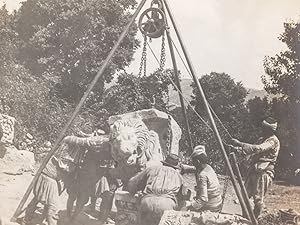gaudin paul french engineer archaeologist (5 résultats)
Type d'article
- Tous les types d'articles
- Livres (5)
- Magazines & Périodiques
- Bandes dessinées
- Partitions de musique
- Art, Affiches et Gravures
- Photographies
- Cartes
-
Manuscrits &
Papiers anciens
Etat
- Tous
- Neuf
- Ancien ou d'occasion
Reliure
- Toutes
- Couverture rigide
- Couverture souple
Particularités
- Edition originale
- Signé
- Jaquette
- Avec images
- Sans impression à la demande
Pays
Evaluation du vendeur
-
Collection of 42 photographs of archaeological objects and excavation sites in the necropolis of Yortan.
Edité par Yortan, 1898-1901., 1901
Vendeur : Antiquariat INLIBRIS Gilhofer Nfg. GmbH, Vienna, A, Autriche
13 x 18 cm and smaller. Glass plate negatives. Historically important photographical documentation of the first excavations in the bronze-age necropolis of Yortan (3rd millennium AD) led by Paul Gaudin. The prehistoric site is located in western Anatolia, about 100 km east of Pergamon, and is famous for its characteristic ceramics that are defining for the Yortan culture. These ceramics show close similarities to those unearthed by Heinrich Schliemann in prehistoric Troy and in several other sites of the wider region. - Paul Gaudin was leading the construction of a railway line from Soma to Pandera, closely passing by Yortan, when he obtained the license (firman) for excavations in the necropolis through Osman Hamdi Bey, the father of Turkish archaeology. The first excavations were conducted in October of 1898, and a second campaign followed in 1901. The French archaeologist Maxime Collignon wrote a brief excavation report in 1901, and many of the ceramics found are now preserved in the Royal Museums of Art and History, Brussels. - Paul Gaudin was born in Paris, the son of the chemist Marc-Antoine Gaudin (1804-80). His passion for photography was certainly inherited from his pioneering father, who in 1841 introduced the usage of bromine fumes to improve the sensitivity of the plates, allowing for a great reduction of the necessary exposure time, and published the first French journal devoted to photographic research, "La Lumière". In 1880, Paul Gaudin completed his engineering training, obtained a position as deputy stationmaster in Paris, and was subsequently employed as an inspector by the Chemins de fer de l'Ouest. His career took an unexpected turn when he was sent to Turkey in 1892 to direct the Moudania-Brousse railroad line operated by the important Belgian investor and engineer Georges Nagelmackers. As early as 1894, after Nagelmackers had obtained the concession for the Smyrna-Cassaba railway, Gaudin was promoted to director of this important line and led its expansions. Paul Gaudin's lasting contributions to archaeology with his excavations in Yortan and in the Hellenistic and Roman city of Aphrosidias (1904 and 1905), as well as his important collection of antiquities, date to his time in Smyrna (Izmir). His most prestigious and challenging position as a railroad engineer, however, was his charge by Sultan Abdul Hamid II to complete the famous Hejaz railway. Despite financial problems, difficult geographical and climatic conditions, and the often hostile (sometimes even violent) reaction of the local population, Gaudin led the rapid expansion of the line from Ma'an to Medina, where the construction came to a definite halt in 1908. During this project, Gaudin was the first to photographically document the Arabic old town of Al-'Ula in 1907. - Little is known of Paul Gaudin's employment after his contract with the Hejaz railway expired in 1909. He briefly collaborated on the disastrous Ottoman project for the construction of a railway line from Hodeidah to Sana'a in 1911 and seems then to have permanently returned to France, where he died in Versailles in 1921. Today, Paul Gaudin is best remembered as a major patron of the Louvre, to which he donated more than 2,000 artifacts from his collection. The Istanbul Museum, the British Museum, and other institutions also owe him important contributions to their Asia Minor, especially Smyrna, antique collections. - Provenance: 1. Collection of Paul Gaudin, family inheritance. 2. Rouillac auction, 20 June 2022, lot 307. - G. Charloux, Paul Gaudin et les premières campagnes de fouilles à Yortan et à Aphrodisias, in: Orient-Express, no. 1, 2001, pp. 24-26. M. Collignon, Note sur les fouilles de M. Paul Gaudin dans la nécropole de Yortan, en Mysie, in: CRAI, 45/6, pp. 810-817.
-
95 photographs of Paul Gaudin's collection of antiquities.
Edité par N. p. o. d.
Vendeur : Antiquariat INLIBRIS Gilhofer Nfg. GmbH, Vienna, A, Autriche
13 x 18 to 24 x 30 cm. Glass plate negatives. Highly interesting photographic documentation of the vast collection that was later dispersed among such important museums as the Louvre, the British Museum, and the Istanbul Museum through donations and sales. The collection was primarily assembled between 1894 and 1905, when Paul Gaudin served as director of the Smyrna-Cassaba railway. During this time, Gaudin led official excavations in the bronze-age Yortan necropolis in Mysia (1898 and 1901) and in the Hellenistic and Roman city of Aphrosidias, Anatolia (1904 and 1905). Some of the objects photographed appear to originate from these archaeological campaigns. The most important part of the collection, however, consisted of figurines from Smyrna (now Izmir) that Gaudin acquired through local antique dealers. - Paul Gaudin was born in Paris, the son of the chemist Marc-Antoine Gaudin (1804-80). His passion for photography was certainly inherited from his pioneering father, who in 1841 introduced the usage of bromine fumes to improve the sensitivity of the plates, allowing for a great reduction of the necessary exposure time, and published the first French journal devoted to photographic research, "La Lumière". In 1880, Paul Gaudin completed his engineering training, obtained a position as deputy stationmaster in Paris, and was subsequently employed as an inspector by the Chemins de fer de l'Ouest. His career took an unexpected turn when he was sent to Turkey in 1892 to direct the Moudania-Brousse railroad line operated by the important Belgian investor and engineer Georges Nagelmackers. As early as 1894, after Nagelmackers had obtained a concession for the Smyrna-Cassaba railway, Gaudin was promoted to director of this important line and led its expansions. Gaudin's most prestigious and challenging position as a railroad engineer, however, was his charge by Sultan Abdul Hamid II to complete the famous Hejaz railway. Despite financial problems, difficult geographical and climatic conditions, and the often hostile (sometimes even violent) reaction of the local population, Gaudin led the rapid expansion of the line from Ma'an to Medina, where the construction came to a definite halt in 1908. During this project, Gaudin was the first to photographically document the Arabic old town of Al-'Ula in 1907. - Little is known of Paul Gaudin's employments after his contract with the Hejaz railway expired in 1909. He briefly collaborated on the disastrous Ottoman project for the construction of a railway line from Hodeidah to Sana'a in 1911 and later appears to have permanently returned to France, where he died in Versailles in 1921. Today, Paul Gaudin is best remembered as a major patron of the Louvre, to which he donated more than 2,000 artifacts from his collection. The Istanbul Museum, the British Museum, and other institutions also owe him important contributions to their Asia Minor antique collections. - Provenance: 1. Collection of Paul Gaudin, family inheritance. 2. Rouillac auction, 20 June 2022, lot 306. - G. Charloux, Paul Gaudin et les premières campagnes de fouilles à Yortan et à Aphrodisias, in: Orient-Express, no. 1, 2001, pp. 24-26.
-
Collection of 19 photographic negatives from Turkey and Yemen.
Edité par Turkey and Yemen, ca. 1892-1911., 1911
Vendeur : Antiquariat INLIBRIS Gilhofer Nfg. GmbH, Vienna, A, Autriche
45 x 60 to 95 x 310 mm. 16 glass plate negatives and 3 film negatives. Highly interesting collection of photographs documenting railway construction in Yemen and Turkey as well as an unidentified oriental port city, among other subjects. Paul Gaudin held important positions as a railway engineer and director in the Ottoman Empire between 1892 and 1911, specifically as director of the Moudania-Brousse railway line (1892-94), the Smyrna-Cassaba railway (1894-1905), the Hejaz railway construction project (1905-08), and in the project for the construction of a railway line from Hodeidah to Sana'a (1911). Six photographs can be linked with certainty to the ill-fated Ottoman project in Yemen. Gaudin dated one of these to 23 March 1911, adding the caption: "Hodeidah, 1st section of the Yemen line (view of the construction site)" (transl.). By the end of 1911, the European experts deemed the recently begun project impossible due to a lack of infrastructure (ports and storage), unfavourable climatic conditions that had already reduced much of the delivered iron to scrap metal, and the disastrous Italo-Turkish War (1911-12). This assessment led the French investors to shut down the project and write off their losses in 1912. The photographs show the port of Hodeidah, newly-built tracks, and building materials. A photograph of Port Saïd in Egypt was probably taken on the way to or from Yemen. Three impressive earlier photographs document railroad work on a dam over a lake in Turkey (before 1905). - Paul Gaudin was born in Paris, the son of the chemist Marc-Antoine Gaudin (1804-80). His passion for photography was certainly inherited from his pioneering father who in 1841 introduced the usage of bromine fumes to improve the sensitivity of the plates, allowing for a great reduction of the necessary exposure time, and published the first French journal devoted to photographic research, "La Lumière". In 1880, Paul Gaudin completed his engineering training, obtained a position as deputy stationmaster in Paris, and was subsequently employed as an inspector by the Chemins de fer de l'Ouest. His career took an unexpected turn when he was sent to Turkey in 1892 to direct the Moudania-Brousse railroad line operated by the important Belgian investor and engineer Georges Nagelmackers. As early as 1894, after Nagelmackers had obtained a concession for the Smyrna-Cassaba railway, Gaudin was promoted to director of this important line and led its expansions. Gaudin's lasting contributions to archaeology with his excavations in the bronze-age Yortan necropolis (1898 and 1901) and in the Hellenistic and Roman city of Aphrosidias (1904 and 1905), as well as his important collection of antiquities, date to his time as director of the Smyrna-Cassaba railway. His most prestigious and challenging position as a railroad engineer, however, was his charge by Sultan Abdul Hamid II to complete the famous Hejaz railway. Despite financial problems, difficult geographical and climatic conditions, and the often hostile (sometimes even violent) reaction of the local population, Gaudin led the rapid expansion of the line from Ma'an to Medina, where the construction came to a definite halt in 1908. During this project, Gaudin was the first to photographically document the Arabic old town of Al-'Ula in 1907. - Little is known of Paul Gaudin's employment after his contract with the Hejaz railway expired in 1909, and he seems to have permanently returned to France after the failed project in Yemen. Today, Paul Gaudin is best remembered as a major patron of the Louvre, to which he donated more than 2,000 artifacts from his collection. The Istanbul Museum, the British Museum, and other institutions also owe him important contributions to their Asia Minor, especially Smyrna, antique collections. - Provenance: 1. Collection of Paul Gaudin, family inheritance. 2. Rouillac auction, 20 June 2022, lot 308. - G. Charloux, Paul Gaudin et les premières campagnes de fouilles à Yortan et à Aphrodisias, in: Orient-Express, no. 1, 2001, pp. 24-26.
-
Collection of 264 photographs from the archaeological site of Aphrodisias.
Edité par [Aphrodisias, 1904-1905]., 1905
Vendeur : Antiquariat INLIBRIS Gilhofer Nfg. GmbH, Vienna, A, Autriche
258 glass plate negatives (9 x 12 to 18 x 24 cm) and 8 panorama nitrate film negatives (31 x 9.5 cm). Extensive photographic documentation of the first official archaeological excavation of Aphrodisias in the historic Caria region, now part of Anatolia, Turkey. Named Aphrodisias in the Hellenistic period, the city gained importance since the 1st century AD as an early and reliable ally of the Roman Empire in the region. During the Roman period, Aphrodisias enjoyed important privileges and became a provincial capital. The well-preserved ruins of public and private buildings excavated since 1904 bear witness to the wealth and importance of Aphrodisias during Imperial times. The city was also a centre of marble production and sculpture, adding greatly to its archaeological significance, as documented in the photographs. In the early 7th century, an earthquake largely destroyed the now Byzantine city that had been renamed Stauropolis around the same time, in an effort to remove pagan connotations. Little remained of Aphrodisias's former importance and splendour thereafter. - Osman Hamdi Bey, the father of Turkish archaeology, had first visited the site of Aphrodisias in 1892 and obtained permission for excavations in 1898. Lacking the necessary funds for a large archaeological campaign, the Francophile Hamdi Bey proposed to Paul Gaudin, then director of the Smyrna-Cassaba railway, to organize excavations in Aphrodisias under his license. A passionate amateur archaeologist who had already led excavations in the bronze-age necropolis of Yortan, Gaudin financed the initial campaign in August 1904. The summer of 1905 saw a more professional campaign under the scientific direction of the French archaeologist Gustave Mendel (1873-1938), with moderate financial support from the French state and private institutions. In August 1905, Paul Gaudin was called to Damascus to serve as director of the Hejaz railway project and therefore was absent for most of the 1905 campaign. Due to a bitter conflict between Gaudin and Mendel the excavations did not continue after 1905, and it was only in 1962 that Kenan Erim began a new campaign under the aegis of New York University that is currently led by Professor R. R. R. Smith (Oxford). - In view of the long interruption of work, Gaudin's photographic documentation is particularly valuable, as many of the archaeological findings have been dispersed among museums in Turkey and Western Europe or even lost over time. As Gaudin's 1904 campaign was not conducted systematically, the earlier photographs provide particularly valuable information concerning the progress of the excavations. - Paul Gaudin was born in Paris, the son of the chemist Marc-Antoine Gaudin (1804-80). His passion for photography was certainly inherited from his pioneering father who in 1841 introduced the usage of bromine fumes to improve the sensitivity of the plates, which allowed for a great reduction of the necessary exposure time, and published the first French journal devoted to photographic research, "La Lumière". In 1880, Paul Gaudin completed his engineering training, obtained a position as deputy stationmaster in Paris, and was subsequently employed as an inspector by the Chemins de fer de l'Ouest. His career took an unexpected turn when he was sent to Turkey in 1892 to direct the Moudania-Brousse railroad line operated by the important Belgian investor and engineer Georges Nagelmackers. As early as 1894, after Nagelmackers had obtained a concession for the Smyrna-Cassaba railway, Gaudin was promoted to director of this important line and led its expansions. Gaudin's lasting contributions to archaeology with his excavations in the Yortan necropolis (1898 and 1901) and in Aphrosidias, as well as his important collection of Smyrnian figurines and other objects, date to his time in Smyrna (Izmir). His most prestigious and challenging position as a railroad engineer, however, was his charge by Sultan Abdul Hamid II to complete the famous Hejaz railway. Despite financial problems, difficult geographical and climatic conditions, and the often hostile (sometimes even violent) reaction of the local population, Gaudin led the rapid expansion of the line from Ma'an to Medina, where the construction came to a definite halt in 1908. During the project, Gaudin was the first to photographically document the Arabic old town of Al-'Ula in 1907. - Little is known of Paul Gaudin's employments after his contract with the Hejaz railway expired in 1909. He briefly collaborated on the disastrous Ottoman project for the construction of a railway line from Hodeidah to Sana'a in 1911, and he seems then to have permanently returned to France, where he died in Versailles in 1921. Today, Paul Gaudin is best remembered as a major patron of the Louvre, to which he donated more than 2,000 artifacts from his collection. The Istanbul Museum, the British Museum, and other institutions also owe him important contributions to their Asia Minor, especially Smyrna, antique collections. - Provenance: 1. Collection of Paul Gaudin, family inheritance. 2. Rouillac auction, 20 June 2022, lot 303. - G. Charloux, Paul Gaudin et les premières campagnes de fouilles à Yortan et à Aphrodisias, in: Orient-Express, no. 1, 2001, pp. 24-26; M. Collignon, Note sur les fouilles exécutées à Aphrodisias par M. Paul Gaudin, in: CRAI, 48/6, 1904, pp. 703-711; A. Le Goff/N. Coutsinax, Les dossiers individuels de mission conservés aux Archives nationales et leur apport à l histoire de l archéologie: l exemple de la fouille d Aphrodisias en 1905, in: Les Nouvelles de l archéologie, no. 110, 2007, pp. 40-47.
-
Two albums with 247 photographs, 1 postcard, and 4 building plans from the archaeological site of Aphrodisias.
Edité par [Aphrodisias, 1904-1905]., 1905
Vendeur : Antiquariat INLIBRIS Gilhofer Nfg. GmbH, Vienna, A, Autriche
45,5 x 36 cm (albums) and various formats (photographs and plans). Extensive documentation of the first official archaeological excavation of Aphrodisias in the historic Caria region, now part of Anatolia, Turkey. The first album contains 199 photographs and the valuable plans, captioned "theatre", "quarries" (with parts of the city), "thermae", and "temple of Aphrodite converted to a Byzantine church; state of the ruins in 1904, indication of the digs". The dating of the album to the first campaign of 1904 suggests that the second album (48 photographs and the postcard) shows the excavations of 1905. The smaller extent of this album agrees well with the fact that Gaudin left Aphrodisias soon after the beginning of the campaign. - Named Aphrodisias in the Hellenistic period, the city gained importance since the 1st century AD as an early and reliable ally of the Roman Empire in the region. During the Roman period, Aphrodisias enjoyed extensive privileges and rose to become a provincial capital. The well-preserved ruins of public and private buildings excavated since 1904 bear witness to the wealth and importance of Aphrodisias during Imperial times. The city was also a centre of marble production and sculpture, adding greatly to its archaeological significance as documented in the albums. In the early 7th century, an earthquake largely destroyed the now Byzantine city that had been renamed Stauropolis around the same time, in an effort to remove pagan connotations. Little remained of Aphrodisias's former importance and splendour thereafter. - Osman Hamdi Bey, the father of Turkish archaeology, had first visited the site of Aphrodisias in 1892 and obtained permission for excavations in 1898. Lacking the necessary funds for a large archaeological campaign, the Francophile Hamdi Bey proposed to Paul Gaudin, then director of the Smyrna-Cassaba railway, to organize excavations in Aphrodisias under his license. A passionate amateur archaeologist who had already led excavations in the bronze-age necropolis of Yortan, Gaudin financed the initial campaign in August 1904. The summer of 1905 saw a more professional campaign under the scientific direction of the French archaeologist Gustave Mendel (1873-1938), with moderate financial support from the French state and private institutions. In August 1905, Paul Gaudin was called to Damascus to serve as director of the Hejaz railway project and therefore was absent for most of the 1905 campaign. Due to a conflict between Gaudin and Mendel the excavations did not continue after 1905, and it was only in 1962 that Kenan Erim began a new campaign under the aegis of New York University that is currently led by Professor R. R. R. Smith (Oxford). - In view of the long interruption of work, Gaudin's photographic documentation is particularly valuable, as many of the archaeological findings have been dispersed among museums in Turkey and Western Europe or even lost over time. As Gaudin's 1904 campaign was not conducted systematically, the earlier photographs provide particularly valuable information concerning the progress of the excavations. - Paul Gaudin was born in Paris, the son of the chemist Marc-Antoine Gaudin (1804-80). His passion for photography was certainly inherited from his pioneering father who in 1841 introduced the usage of bromine fumes to improve the sensitivity of the plates, which allowed for a great reduction of the necessary exposure time and published the first French journal devoted to photographic research, "La Lumière". In 1880, Paul Gaudin completed his engineering training, obtained a position as deputy stationmaster in Paris, and was subsequently employed as an inspector by the Chemins de fer de l'Ouest. His career took an unexpected turn when he was sent to Turkey in 1892 to direct the Moudania-Brousse railroad line operated by the important Belgian investor and engineer Georges Nagelmackers. As early as 1894, after Nagelmackers had obtained the concession for the Smyrna-Cassaba railway, Gaudin was promoted to director of this important line and led its expansions. Paul Gaudin's lasting contributions to archaeology with his excavations in the Yortan necropolis (1898 and 1901) and in Aphrosidias, as well as his important collection of Smyrnian figurines and other objects, date to his time in Smyrna (Izmir). Gaudin's most prestigious and challenging position as a railroad engineer, however, was his charge by Sultan Abdul Hamid II to complete the famous Hejaz railway. Despite financial problems, difficult geographical and climatic conditions, and the often hostile (sometimes even violent) reaction of the local population, Gaudin led the rapid expansion of the line from Ma'an to Medina, where the construction came to a definite halt in 1908. During this project, Gaudin was the first to photographically document the Arabic old town of Al-'Ula in 1907. - Little is known of Paul Gaudin's employments after his contract with the Hejaz railway expired in 1909. He briefly collaborated on the disastrous Ottoman project for the construction of a railway line from Hodeidah to Sana'a in 1911 and seems later to have permanently returned to France, where he died in Versailles in 1921. Today, Paul Gaudin is best remembered as a major patron of the Louvre, to which he donated more than 2,000 artifacts from his collection. The Istanbul Museum, the British Museum, and other institutions also owe him important contributions to their Asia Minor, especially Smyrna, antique collections. - Collection of Paul Gaudin, family inheritance. - G. Charloux, Paul Gaudin et les premières campagnes de fouilles à Yortan et à Aphrodisias, in: Orient-Express, no. 1, 2001, pp. 24-26; M. Collignon, Note sur les fouilles exécutées à Aphrodisias par M. Paul Gaudin, in: CRAI, 48/6, 1904, pp. 703-711; A. Le Goff/N. Coutsinax, Les dossiers individuels de mission conservés aux Archives nationales et leur apport à l histoire de l archéologie: l exemple de la fouille d Aphrodisi.






